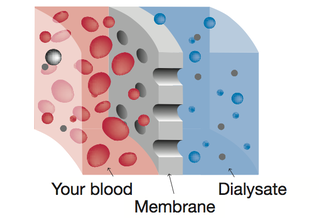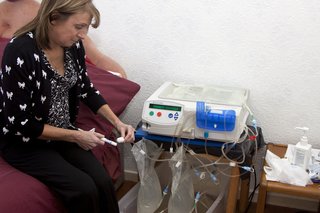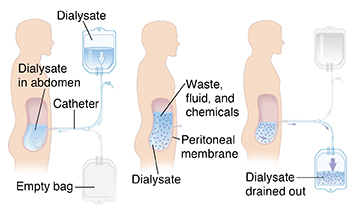Dialysis is an artificial method of filtering the blood to remove toxins, excess salts and water – in other words, the normal role of the kidneys. There are two types: peritoneal dialysis (PD) and haemodialysis (HD). This article discusses peritoneal dialysis and how it works.
What is peritoneal dialysis and how does it work?
Peritoneal dialysis (PD) is one of the two main types of dialysis. It is a treatment for end-stage kidney disease (Stage 5 CKD, or kidney failure).
A few weeks before you start peritoneal dialysis, a surgeon places a soft tube, called a catheter, in your belly.
How PD removes wastes from the body
During peritoneal dialysis, a cleansing fluid (called dialysis fluid, or dialysate) flows through the catheter into the abdomen. The inner lining of the abdomen, known as the peritoneum, acts as a ‘semi-permeable membrane’ (filter) and removes wastes from the blood.

In PD, the peritoneum is the semi-permeable membrane (filter). In this way the peritoneum is equivalent to the artificial kidney (dialyser) in haemodialysis. As in haemodialysis, the chemical process that carries out the filtering is called ‘diffusion’. This is explained further in the how haemodialysis works page.
After a set amount of time, the fluid with the filtered waste flows out of the abdomen and is thrown away (into a toilet).
Then, you start over with a fresh bag of dialysis fluid. You need to repeat the process of emptying the used solution and refilling your belly with fresh solution about four times every day. This process is called an exchange.

A patient reading during a PD exchange
Because peritoneal dialysis works inside the body, it is different from haemodialysis, which cleans the blood directly. That procedure filters blood outside the body in a machine.
What are the two types of peritoneal dialysis?
These are the two types of peritoneal dialysis:
- Continuous ambulatory peritoneal dialysis (CAPD). You usually do four exchanges manually during the day, leaving the fluid in for 4-8 hours. Each exchange takes 20-30 minutes
- Automated peritoneal dialysis (APD). This is done at night, for 8-10 hours, using a machine that pumps the fluid in and out.

A patient using an APD machine
You can choose the one that best fits your life. If one type of peritoneal dialysis does not suit you, talk with your doctor about trying the other type.
When do you need to start dialysis (or a kidney transplant)?
If you reach Stage 5 CKD, doctors consider you to be in end-stage renal disease (ESRD) or kidney failure. At this point, the kidneys are carrying out around 10% to 15% of their normal function. This is not enough to stay well. So you will need to start dialysis (or have a renal transplant).
Peritoneal dialysis (like haemodialysis) provides about 5% kidney function. Whereas a well functioning kidney transplant provides 50% of the function of two normal kidneys.
Dialysis (or a transplant) can help you feel better and live longer, but they are not cures for kidney failure.
Last Reviewed on 9 September 2023

